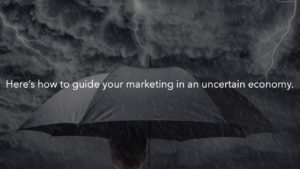It’s been a wild economic ride, and it won’t stop for this calendar year – at least. That’s our collective reality, so let’s make the most of it for our brands and customers.
In an unpredictable economic landscape, we all face the challenge of maintaining stability in revenue, profitability, market share, and customer loyalty. Understanding how to navigate market volatility today is a do-or-die skill. The good news – according to Insider Intelligence and eMarketer, consumer spending grew at typical levels in 2022 (meaning less than in the online shopping-crazed pandemic era). Based on projections, we can expect a similar level of growth in 2023 (~4.5%). But how do we prepare to make the most of that ~4.5% growth? We’ll get into that, but first, let’s parse out precisely what we think will go down during the most critical part of the year for most businesses – this holiday season. We’ll highlight the central factors determining your business’ success leading into, and during, that make-or-break time of year.
Note: We have no affiliation, nor do we receive any compensation from the companies we mention in this article. They are all companies we’ve had good experiences with, and we’re sharing them with you.
Predictions for the 2023 Holiday Season
While predicting market movements with certainty is challenging, understanding consumer trends and expectations does provide insight into the upcoming holiday season. Here are a few predictions for businesses during this period:
E-commerce’s Continued Dominance: No surprise here – the growth of online shopping is expected to continue, with more consumers embracing the convenience and safety of e-commerce. According to Forbes, last year, online sales climbed from $257 billion in 2021 to a whopping $270 billion in 2022, which amounts to a 4.8% growth rate. Despite the uncertainty, a similar level of e-commerce growth is expected for this year. Businesses that invest in robust online platforms, optimize their digital presence, and offer seamless online shopping experiences will likely thrive during the holiday season. BTW – you need to look at your supply chain and fulfillment (3PL) as a profit center. Excellent execution in this area is one of the top 2 factors in keeping customer shopping with you. Standvast is one of the best 3PLs (third party logistics) out there, so give them a look.
Personalized and Unique Experiences: We’ve heard it for years, but most brands are still struggling to execute well on this – consumers respond exponentially better (aka buy more) when given personalized and unique experiences, even during the holiday season. Businesses that provide customized offerings, immersive experiences, and thoughtful gifting options are poised to attract many more customers than their bland counterparts. According to McKinsey & Co., personalizing customer experiences brings up to a 10-15% revenue uplift. Consider creating limited-edition products, offering exclusive promotions, or partnering with other businesses to enhance the overall customer experience.
Sustainability and Ethical Practices: Environmental and social consciousness influence consumer choices. Businesses prioritizing sustainability, ethical sourcing, and responsible practices resonate with consumers. Highlight your eco-friendly initiatives, support local communities, and offer transparent information about your products’ origins to appeal to socially conscious customers. This said, there are two keys to success here – 1) this works best with GenZ and young Millenials; 2) the vast majority of customers have a clear “convenience threshold” when it comes to this. Our rule of thumb is 5% – customers will expend 5% more effort or pay 5% more or accept 5% less for eco-friendly anything. Go beyond the 5%, and they will often opt-out.
How to Prepare Your Marketing Strategy for Holiday 2023
Customer Retention and Relationship Building During These Wild Times
During periods of market instability, nurturing existing customer relationships becomes paramount because they are more fickle than during more steady times. It’s more complex and more expensive than ever to acquire a customer. Businesswire reports that customer acquisition costs increased over 200% in the last 10 years. To make the most of your customer acquisition costs, you need to allocate equal resources to keeping the customers you already have as to getting new ones. Meaning, you must allocate resources to the table stakes of building strong customer loyalty programs, offering exceptional customer service, and personalizing your interactions. We’ve all heard that 100x before, but we still see brands not doing it enough. Here’s the real magic – offer something material and unique just for your current customers on the same level (or higher) that you would provide a new customer. For example, 15% off of their subscription for 3 months (during the holiday season) just for being a great customer – AT&T did something similar a couple of years ago, and it worked really well. Position it as “we know it’s a tough time, so we’re doing what we can to make it easier for you – now go spend a little extra on the ones you love.” Retaining loyal customers sustains revenue during challenging times and keeps that critical foundation for future growth.
Personalize the Customer Experience
Before you say, “Personalization at scale is too resource intensive and expensive,” let’s just say… we’re not buying it. With the latest (inexpensive) marketing automation tools, that just doesn’t hold up in most cases – some yes – most no. We’ve provided some examples of the tech in the coming sections, so dig in, and you’ll be surprised what’s achievable now.
According to Insider Intelligence, 73% of customers expect businesses to understand their unique needs and preferences. To truly understand your customer’s unique needs and preferences, you must constantly and actively seek their feedback to know where you have room for improvement.
As defined by the Adobe Experience Cloud Blog, the customer experience personalization process involves identifying who your customers are, defining your typical customer journey, developing personalization standards, analyzing customer data along the customer journey, and segmenting your audience. By doing these things, you enable detailed customer experiences that resonate with your different audiences. This process involves implementing surveys, feedback forms, or online reviews to gather insights into their satisfaction levels and expectations. Analyze this feedback and use it to make necessary adjustments and address pain points to enhance the customer experience.
This goes without saying, but if your customers have customer service complaints, address them immediately. Once you destroy your reputation in the eyes of your customers, it’s near impossible to repair. To reinforce this commonly experienced phenomenon, Forbes emphasizes that 96% of customers will never return to buy again from your business. It may seem like a losing battle to respond to every customer complaint, but customer service software like Gorgias or Zendesk will help you stay on top of things. If you skimp on customer service, you will lose out on repeat business.
Use the data that you have on hand, including customer purchase behavior, customer browsing behavior, customer reviews, and survey results, to create informative and valuable content, such as blog posts, videos, or guides, that address their pain points, provide solutions, or offer insights. Distribute this content through various channels, including your website, social media, and email newsletters. By positioning your business as a trusted source of information and actively engaging with your customers, you nurture long-term profitable relationships.
Implement a Customer Loyalty Program – Where It Makes Sense
Let’s be realistic – loyalty programs are expensive to maintain, and too many of them don’t give you the MROI (marketing return on investment) that makes sense for your business. That said, most of the programs that don’t generate a reasonable return are just not well done – many brands half-ass their programs and then call them a failure. Look to companies like REI, H&M, Sephora, Amazon, and Starbucks to learn from the best. And if you’re going to commit to a loyalty program, here are some things to consider (if you’re not going to truly commit, skip this section and go to the next section):
To incentivize purchases further and retain customers, a loyalty program encourages long-term devotion to your business for your clientele. Offer rewards, discounts, or exclusive benefits to customers who consistently engage with your business. According to Forbes, the ideal loyalty program should be easy to understand, accessible, and provide tangible value. Regularly communicate with your loyal customers to keep them engaged and informed about program updates and special offers.
If your business doesn’t have an ideal model to provide a loyalty program, even a simple “thank you” email goes a long way to show that you appreciate that they chose you. Yes, you provide a great product/service to them, but your relationship brings a mutual benefit. By focusing on the human relationship between your customers and your brand or business, you incentivize them to stick around longer.
Remember, customer retention and relationship building are ongoing efforts that require a customer-centric approach and continuous dedication. By personalizing experiences, providing exceptional service, implementing loyalty programs, soliciting feedback, fostering engagement through content marketing, offering exclusive benefits, and maintaining regular communication, businesses can cultivate solid and lasting relationships with their customers, even in an unstable market.
Optimize Operational Efficiency
Enhancing operational efficiency keeps your board and executive team happy because they don’t feel they have to shore things up to weather the storm of unstable markets. This is vital for businesses as well as your personal sanity. To start, review your marketing processes and identify areas where inefficiencies exist – we all have them, so don’t feel embarrassed. Streamline workflows by eliminating redundant tasks, automating repetitive processes, and implementing marketing technology tools. As we detailed in our recent blog post, AI in marketing brings significant productivity gains when used correctly. By streamlining your marketing processes, you save time and resources, allowing your team to focus on revenue-generating initiatives.
Adopt Agile Marketing Practices
To understand what agile marketing is, it’s helpful to start by describing what it’s not. As McKinsey & Co. states in its guide on agile marketing, it doesn’t involve taking 8 whole weeks to implement a simple email A/B test. To be agile, you must constantly test marketing initiatives, assess results using accurate data, and quickly and efficiently implement results. Focus on increasing flexibility and responsiveness in your marketing department so you can adapt quickly in a rapidly changing market. By breaking down large marketing initiatives into smaller, manageable tasks that can be executed in shorter timeframes, you gain valuable data that drives the advancement of the entire business. Conduct frequent performance reviews and adapt your strategies based on data-driven insights and market feedback. Continuously iterate quickly, optimize campaigns on the fly, and capitalize on emerging opportunities or risk falling behind. If you struggle with agile marketing practices, that’s our specialty at IDLab. Drop us a line if you think you could use some guidance.
To be candid, all of the things we cited above are the keys to faster speed-to-market, but when you get to the core of a slow marketing department, experience has shown us time and time again that it comes down to two things:
- Analysis Paralysis – the need to put a digit beside absolutely everything and then over analyzing things that don’t have a material effect on success
- Risk Aversion – the core of marketing is emotion, and resonating on an emotional basis requires putting yourself out there; taking risks. Patagonia did this with their “Don’t Buy This” campaign, and it was a huge success (and a huge risk)!
Invest in Marketing Technology
Evaluate your marketing tech stack and invest in tools that can automate repetitive tasks, improve data analysis, and enhance campaign management. Marketing automation platforms, customer relationship management (CRM) systems, content management systems (CMS), and social media management tools can streamline processes, increase productivity, and improve the effectiveness of your marketing efforts. For managing marketing leads and account management, we love Close CRM. It seamlessly integrates with almost any other tool in your tech stack. Try Hubspot (if you haven’t already) to manage your marketing content, social media, and more all in one place. These are just two examples of tools we love, but there are many more to choose from. Take a look and see what’s out there; we guarantee that you’ll find something that works for you.
By optimizing operational efficiency in your marketing efforts, you can maximize the impact of your campaigns, make informed decisions, and adapt quickly to market changes. By adopting agile practices, continuously testing and optimizing, and investing in marketing technology will enable you to achieve greater efficiency and effectiveness in your marketing strategies, even in an unstable market.
We are big believers in leveraging tech in marketing, but that said, if you’re not going to train your people to use the tools properly, monitor to make sure the team is using the tools, and incentivize your team to use them – don’t bother with the tech. Yes, you will be inefficient, but spending money on things to make you efficient and then not using them to their fullest is just compounding the costs of inefficiency.
Innovate and Adapt to Changing Customer Needs
Innovation is vital to surviving and thriving in an unstable market. Continually assess your products, services, and business model to identify opportunities for improvement or adaptation. Embrace emerging technologies (and not just AI) and market trends to meet changing customer needs. To meet your customers where they are, experiment with new channels. It may be a risk to experiment, but the most significant threat is staying in place and falling behind in today’s rapidly evolving marketing ecosystem. By staying agile and responsive to market shifts, you can position your business for stability and capitalize on new opportunities.
We recently “pushed” a client into TV and streaming media at their behest. They were stuck on traditional digital (FB in particular) and were not willing to risk reducing spend in those channels for unfamiliar ones. They listened to us and had a massive lift in conversion. Innovation doesn’t have to be a world-changing event; it can be a simple thing like exploring new channels, but the point is the same – innovate (experiment) or wither on the vine.
Embrace New Technology to Drive Marketing Innovation
Regarding marketing innovation, don’t underestimate the power of AI and machine learning. These technologies can be game-changers for your business. Imagine using AI-powered marketing tools to understand your customers better, offer personalized recommendations, and even automate specific tasks. And don’t forget about chatbots and virtual assistants like Tidio or SmartLoop; they provide top-notch customer support and engagement. By embracing AI and machine learning, you’ll streamline processes, create personalized experiences, and make smarter decisions based on data.
Have you considered incorporating augmented reality (AR) and virtual reality (VR) into your marketing strategies? AR allows customers to visualize your products in their surroundings (like 3DLook, a virtual e-commerce fitting room), making the buying experience more immersive and exciting. Similarly, VR opens up a new world of storytelling and events that captivate your audience like never before. By embracing AR and VR, you’ll grab attention, increase engagement, and set your brand apart. AI, machine learning, AR, and VR aren’t just buzzwords—they’re powerful tools that can revolutionize your marketing efforts and help your business thrive in today’s dynamic landscape.
Structure an Omni-Channel Strategy for Seamless Customer Experience
When it comes to reaching your customers, it’s all about providing a seamless experience across online and offline channels. Break down those barriers and make it easy for customers to switch between browsing online and making purchases in-store without any hassle. Keep your messaging, branding, and promotions consistent across all touchpoints, creating a cohesive experience that resonates with your customers. And here’s the secret sauce: implement cross-channel personalization. Use customer data to personalize messages, recommendations, and promotions based on their preferences. Whether through email, websites, or social media, deliver tailored content that speaks directly to them. By doing this, you’ll supercharge customer engagement and drive those conversions you’re after.
We recently worked with a real estate marketing leader on their OOH (out of home) and DM (direct mail) “ecosystem.” Both tactics were not performing for them. When we looked at the channels, we knew both would perform – the company was just doing it wrong. To prove it, we did just OOH – which failed as predicted. Then we did just DM – which was mediocre at best. Then we did both simultaneously and saw an exponential increase in conversion. Today, you have to have an ecosystem and not standalone channels.
Navigating an unstable market is a challenge for businesses, but with the right approach, stability is achievable. Strategic planning, adaptability, and diversifying revenue streams are essential steps. Stay updated on market trends, prioritize customer retention, boost operational efficiency, and embrace innovation. For the holiday season, align strategies with e-commerce, focus on personalized experiences, and incorporate sustainability. By following these strategies, you will thrive and find stability for your brand. Need help with that? Strategy development is here when you need it.





